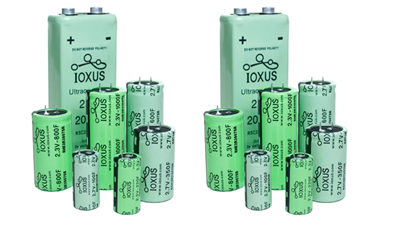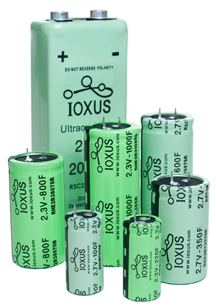
Advantages of pairing ultracapacitors with batteries outweigh the drawbacks
By Brendan Andrews

A number of factors in play for engineers considering hybridized energy storage may raise questions over the complexities and of increased costs for dual-storage systems. The electronics required for balancing separate batteries and ultracapacitors in one component may also be a concern. The decision makers might also point to the timeline as a potential drawback for a hybridized energy storage solution.
Nonetheless, considering the numerous and significant benefits to pairing traditional batteries with ultracapacitors optimized for higher voltage levels, the value of hybridization becomes very clear and compelling.
There are essentially seven reasons to embrace hybridized storage:
1. Cost — This is often the number-one concern with any change in manufacturing practice, so let’s address it first. In this category, ultracapacitors win big. The price of these components has fallen 99 percent in the past decade, while battery costs have come down only 30 to 40 percent in the same time period.
2. Power — Ultracapacitors allow design engineers to separate energy and power needs. In most applications there is a continuous energy demand that is handled by a primary energy source. At times, there are peak power demands. Engineers can either size the batteries to handle peak demands or use ultracapacitors to bridge the demand, which has the added benefit of being able to downsize the primary energy source.
High-power ultracapacitors provide the burst power required by high current demands associated with acceleration, starting, steering and regeneration. The industry has widely recognized that pairing a capacitor with a battery will improve the power density of the hybrid supply, which has the added advantage of allowing the battery to operate without seeing the large current spikes that would be present in the absence of the capacitor.
3. Temperature — Where batteries lose most of their available energy at 0-degrees and below, ultracapacitors perform under a wide range of climate conditions, typically from plus-70 degrees to minus-40 degrees Celsius. For batteries, the temperature range is best from minus-40 to plus-65, with the average type from minus-20 to plus-60.
4. Cycle life — Batteries rely on a chemical reaction to dissipate stored energy. There is no chemical reaction in ultracapacitors, as they store energy in an electrostatic field. This lack of chemical change is the reason that ultracapacitors will last more than a million cycles, versus the hundreds to low thousands of cycles for various batteries.
5. Efficiency — Ultracapacitors are 95 to 98 percent efficient, whereas lead-acid batteries measure, at best, 70 percent efficiency. Ultracapacitors can begin to accept a charge from zero volts, while batteries require the input to reach a certain voltage before accepting a charge. Also, one can discharge an ultracapacitor to zero volts, which would destroy a battery.
6. Better battery performance — Batteries are designed and built to provide high-energy density, and do a much better job of this when they are used in conjunction with ultracapacitors. designed for, which is For example, when a hybrid vehicle accelerates, there is a huge demand for power in the form of amps (current). Putting ultracapacitors in parallel with batteries along with control electronics allows ultracapacitors to provide high current, enabling the batteries to become strictly an energy source, rather than an energy and power source. The hybridized energy storage system then works together, forming an energy-dense, high-power solution with long life and increased reliability. This combination can also decrease the warranty and replacement cost of the batteries, making the system economically attractive.
7. Hybridization increases battery life — In many applications, ultracapacitors will not replace batteries. But since ultracapacitors have a much lower internal resistance and much faster charge rate, they make battery-powered systems run more efficiently. Ultracapacitors make batteries last longer because they do the brunt of the work when the load is initially switched on and allow the battery to pick up load gradually, preventing high current draws from the battery. By gradually taking on a load, batteries are insulated from high current drains that cause thermal, chemical, and mechanical stresses. By reducing current spikes, the internal temperature of batteries is decreased substantially, extending the life of the batteries by as much as 400 percent, depending on the application. Additionally, there are times when a battery simply cannot deliver the current needed for an application.
The ability to prevent the battery from experiencing these large current demands under load allows the battery to have a longer effective life. A typical starter battery, for example, will degrade quickly if it is required to supply high current for any length of time. So-called deep cycle batteries are designed specifically to supply higher currents, but even such batteries with their thicker lead plates are not immune from damage due to repeated deep cycling. A parallel configuration of a battery with an ultracapacitor can dramatically reduce the deep cycling of the battery under heavy load conditions and thus extend the life of the hybrid power supply as well as provide a more efficient supply.
Why hybridize?
Combinations of ultracapacitors and batteries in energy storage systems can reduce the size, weight, and the number of batteries in a system. Such hybridized systems are more efficient and use fewer materials. They can also extend the cycle life of the battery component, which makes the whole system greener.
Furthermore, in nearly every conceivable category, hybridized energy storage offers advantages that dramatically outweigh the minimal drawbacks associated with pairing ultracapacitors and batteries. The beauty of hybridization is in the equal benefits delivered by both elements. An ultracapacitor enables the reduction of battery currents and cycling range, delivering a positive effect on overall lifespan and efficiency. When considered along with gains in power and energy capabilities, one can see the significant, measurable worth of hybridization. BR
Brendan Andrews serves as vice president, sales and marketing for Ioxus, Inc, Oneonta, NY. Previously, he served with Maxwell Technologies as director of sales and marketing, Americas.

Can a bus be run solely from Ultra Capacitors?